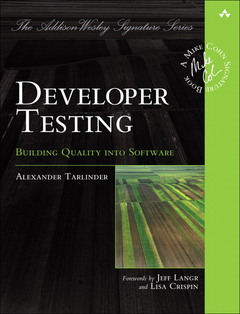Description
Developer Testing
Building Quality into Software
Addison-Wesley Signature Series (Cohn) Series
Author: Tarlinder Alexander
Language: English
Approximative price 38.29 €
In Print (Delivery period: 14 days).
Add to cart352 p. · 18x23 cm · Paperback
Description
/li>Contents
/li>Biography
/li>Comment
/li>
You can quickly begin using Tarlinder?s technology-agnostic insights with most languages and toolsets while not getting buried in specialist details. The author helps you adapt your current programming style for testability, make a testing mindset ?second nature,? improve your code, and enrich your day-to-day experience as a software professional. With this guide, you will
- Understand the discipline and vocabulary of testing from the developer?s standpoint
- Base developer tests on well-established testing techniques and best practices
- Recognise code constructs that impact testability
- Effectively name, organise, and execute unit tests
- Master the essentials of classic and ?mockist-style? TDD
- Leverage test doubles with or without mocking frameworks
- Capture the benefits of programming by contract, even without runtime support for contracts
- Take control of dependencies between classes, components, layers, and tiers
- Handle combinatorial explosions of test cases, or scenarios requiring many similar tests
- Manage code duplication when it can?t be eliminated
- Actively maintain and improve your test suites
- Perform more advanced tests at the integration, system, and end-to-end levels
- Develop an understanding for how the organisational context influences quality assurance
- Establish well-balanced and effective testing strategies suitable for agile teams
- Chapter 1: Developer Testing
- Chapter 2: Testing Objectives, Styles, and Roles
- Chapter 3: The Testing Vocabulary
- Chapter 4: Testability from a Developer’s Perspective
- Chapter 5: Programming by Contract
- Chapter 6: Drivers of Testability
- Chapter 7: Unit Testing
- Chapter 8: Specification-based Testing Techniques
- Chapter 9: Dependencies 1
- Chapter 10: Data-driven and Combinatorial Testing
- Chapter 11: Almost Unit Tests
- Chapter 12: Test Doubles
- Chapter 13: Mocking Frameworks
- Chapter 14: Test-driven Development—Classic Style
- Chapter 15: Test-driven Development—Mockist Style
- Chapter 16: Duplication
- Chapter 17: Working with Test Code
- Chapter 18: Beyond Unit Testing
- Chapter 19: Test Ideas and Heuristics
- Appendix A: Tools and Libraries
- Appendix B: Source Code
- Bibliography
- Index
Alexander Tarlinder wrote his first computer program around the age of ten, sometime in the early nineties. It was a simple, text-based role playing game for the Commodore 64. It had lots of GOTO statements and an abundance of duplicated code. Still, to him, this was the most fantastic piece of software ever conceived, and an entry point to his future career.
Twenty-five years later, Alexander still writes code and remains a developer at heart. Today, his professional career stretches over 15 years, a time during which he has shouldered a variety of roles: developer, architect, project manager, ScrumMaster, tester, and agile coach. In all these roles, he has gravitated towards sustainable pace, craftsmanship, and attention to quality, and he eventually got test infected around 2005. In a way, this was inevitable, since many of his projects involved programming money somehow (in the banking and gaming industry), and he always felt that he could do more to ensure the quality of his code before handing it over to someone else.
Presently, Alexander seeks roles that allow him to influence the implementation process on a larger scale. He combines development projects with training and coaching, and he shares technical and nontechnical aspects of developer testing and quality assurance in conferences and local user groups meetings.
The practical guide to writing testable code, avoiding unnecessary bugs, and achieving superior software quality
- Answers crucial developer questions such as: When have I tested this enough? How many unit tests do I need to write? What should my test verify?
- Helps developers start thinking about testability without getting buried in specialist details
- Offers practical guidance on transforming suboptimal legacy code into manageable, testable pieces
- Reflects the author's extensive consulting, training, and mentoring experience, and his deep understanding of development teams' QA learning curves
- Offers "technology-agnostic" insights you can use with any new language or toolset
- The perfect companion to all testing and quality assurance books in Mike Cohn's Signature Series




